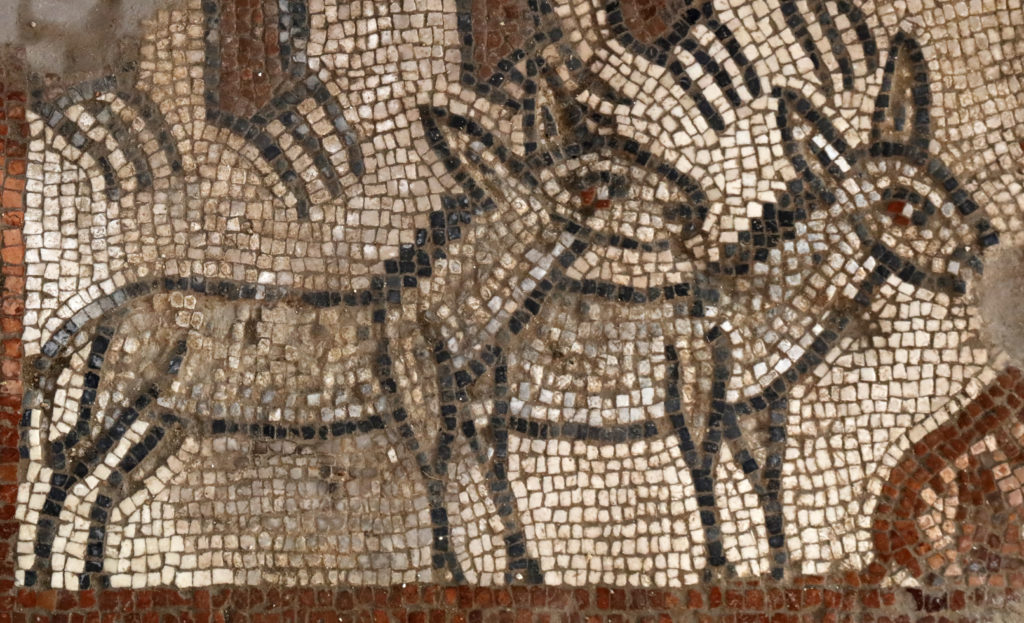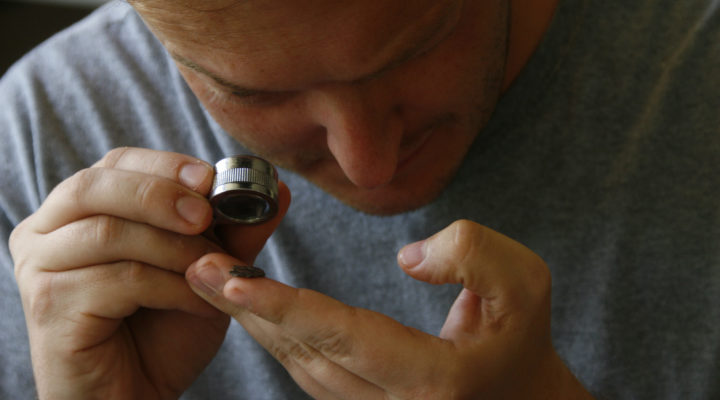Kentucky isn’t the only place where Noah’s ark is making headlines these days.
While Ken Ham’s “Ark Encounter” museum near Williamstown, Ky., has gotten the lion’s share of attention this summer, another representation of Noah’s vessel in Israel has been wowing the archaeological world.
And a Baylor University scholar has been among those at the forefront of the discovery.
Baylor coin specialist Nathan Elkins, assistant professor of art history, worked alongside a consortium of universities this summer in Huqoq, Israel, to excavate an ancient synagogue and discovered mosaics depicting the stories of Noah’s ark and the parting of the Red Sea.

One of the Noah’s ark mosaics uncovered in Huqoq, Israel, showing two donkeys. (Photo/Baylor University)
The mosaics were found decorating the nave floor of a synagogue that dates to the fifth century, when the region was part of the Roman Empire. They depict an ark and pairs of animals including elephants, leopards, donkeys, snakes, bears, lions, ostriches, camels, sheep and goats. They also show Pharaoh’s soldiers being swallowed by large fish, surrounded by overturned chariots with horses and chariot drivers.
“These scenes are very rare in ancient synagogues,” Jodi Magness, director of the excavations and professor in the University of North Carolina at Chapel Hill’s College of Arts and Sciences, said in a UNC news release. “The only other examples that have been found are at Gerasa/Jerash in Jordan and Mopsuestia/Misis in Turkey, and at Khirbet Wadi Hamam in Israel and Dura Europos in Syria.”
Elkins recently spoke at the public hearing of the Cultural Property Advisory Committee at the U.S. Department of State in Washington, about the necessity of protecting ancient coins from looting and smuggling. He spoke in favor of renewing the Memoranda of Understanding that would help prevent and stop the looting of undocumented ancient coins and antiquities from Greece into the United States. During the Huqoq excavation, he serves as the numismatist, or coin specialist, on site.
“The ancient coins at Huqoq, which I study, span 2,300 years at the site and are critical for our knowledge of the monumental synagogue and the associated village,” Elkins said.

A mosaic discovered in an ancient synagogue in Israel depicting the parting of the Red Sea. (Photo/Baylor University)
Baylor is one of four schools sponsoring and participating in the Huqoq excavations. The others are the University of North Carolina, Brigham Young University and the University of Toronto, and students and staff from each university have helped in the excavations.
“It is a great pleasure to be a staff member at Huqoq, a site that garners worldwide attention on account of the significance of the monumental synagogue and its unprecedented mosaic find,” Elkins said. “It is also wonderful that I have been able to involve Baylor students in this excavation each year.”
The work will continue, he said.
“Next summer, we expect Baylor participation in this excavation to become more formalized via a Baylor study abroad program called ‘Baylor in the Galilee’, which I hope will increase Baylor student involvement.”
This summer, Baylor University students Sara Beth Burch, a sophomore majoring in art history, and Nathaniel Eberlein, a senior university scholar, helped with the excavations.
Excavations have been conducted in the synagogue every summer since the first mosaics were found in 2012. Since then, mosaics depicting Samson and his foxes (Judges 15:4), Samson carrying the gate of Gaza on his shoulders (Judges 16:3) and a scene containing a Hebrew inscription surrounded by human figures, animals and mythological creatures such as putti, or cupids, have been uncovered. The first non-biblical mosaic ever found in an ancient synagogue was also discovered at Huqoq and showed the legendary meeting between Alexander the Great and a Jewish high priest.
The mosaics uncovered by the excavations have been removed from the site for conservation, and the excavated areas have been backfilled. Financial support for the 2016 excavations also was provided by the National Geographic Society and the Memorial Foundation for Jewish Culture.
— Portions of this story originally appeared at Baylor.edu.


